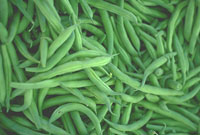French Beans
 French Beans are an ideal plant to grow. They are compact, need little attention and give a very rewarding crop compared to the amount of space needed to grow them.
French Beans are an ideal plant to grow. They are compact, need little attention and give a very rewarding crop compared to the amount of space needed to grow them.
French Beans do best in a sunny, sheltered position. They prefer a lighter soil that is well fertilised, with a pH of 7.0 - 8.0, but will in fact grow in most soils.
The seeds will not germinate below 60 F (16 C) and they are susceptible to frost. For these reasons, it is best to wait until May when the soil has warmed up, and there is no (or little) chance of frost, before sowing.
Sow the seed 2" deep in twin drills 1' apart. Space further rows 2' apart. Place the seeds at 6" intervals along the rows.
French Beans do not transplant particularly well, but, if you prefer to start some in the greenhouse for transplanting, use peat pots which will lessen the chance of root disturbance.
They will produce heavier crops if kept free of weeds and well watered, particularly during dry weather. If the flowers start to droop during hot weather, spray with water. This will help to keep the flowers open so that insects can pollinate them.
Regular hoeing will not only keep the plants free of weeds but will help to keep the soil broken up, and so help water penetration to the roots.
As French Beans do not tend to grow very high, they do not normally need support, but if the crop of beans is heavy, you may find that they droop onto the ground, so becoming more vulnerable to slug damage, and in wet weather will get splashed with soil. Support with pea sticks or small canes if this is the case.
On rare occasions, you may find that a plant throws out a runner and tries to climb. Cut these runners off if found.
Pick the pods as they mature. It is better to pick them while still young and tender, if left too long they can become tough and 'woody'. Test by snapping a pod in half. If it snaps cleanly, it is ready for picking, older pods will usually leave a string between the two halves. To avoid damaging the plant when picking, use scissors to remove the pods.
The beans of some varieties, if left to fully ripen, can be dried and stored for winter use. These are referred to as Haricot beans.
When harvesting has finished cut the plant off at ground level. Dispose of the tops by putting on the compost heap but leave the roots in the ground they will retain the nitrogen for use by the next crop to be grown on the site.
Slugs are usually the biggest problem but other pests and diseases can include Bean beetle, Capsid bugs, Blackfly, Bean seed fly, Red Spider Mites, Halo Blight, Anthracnose, Root or Foot rot and Mosaic and Yellow Virus diseases. (See respective Pests or Diseases section)
© copyright 1999, P. A. Owen

